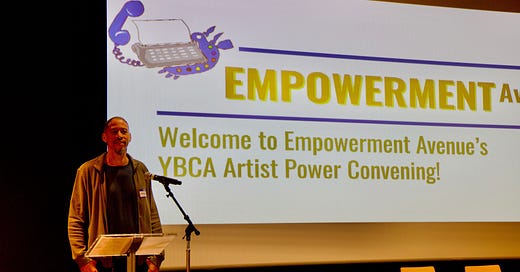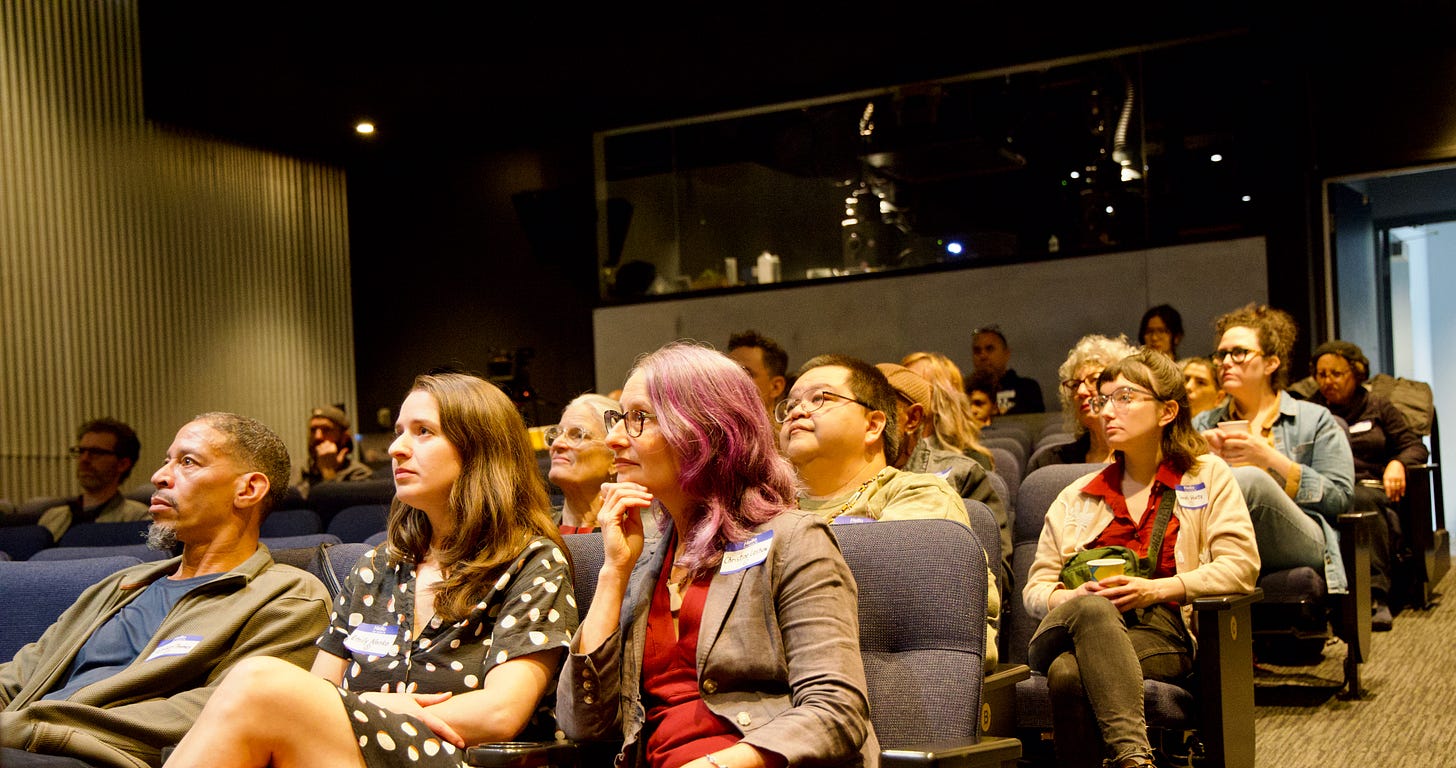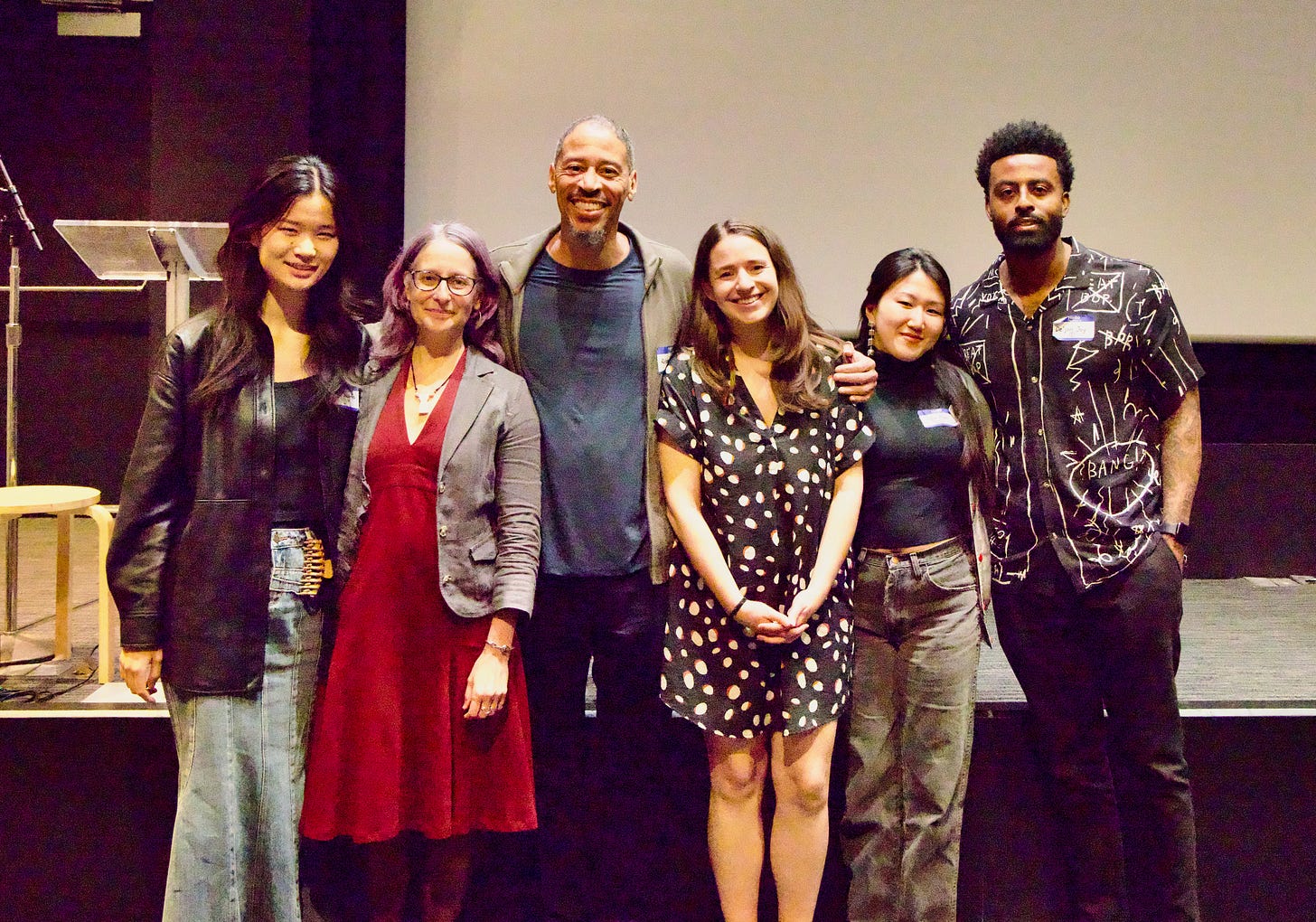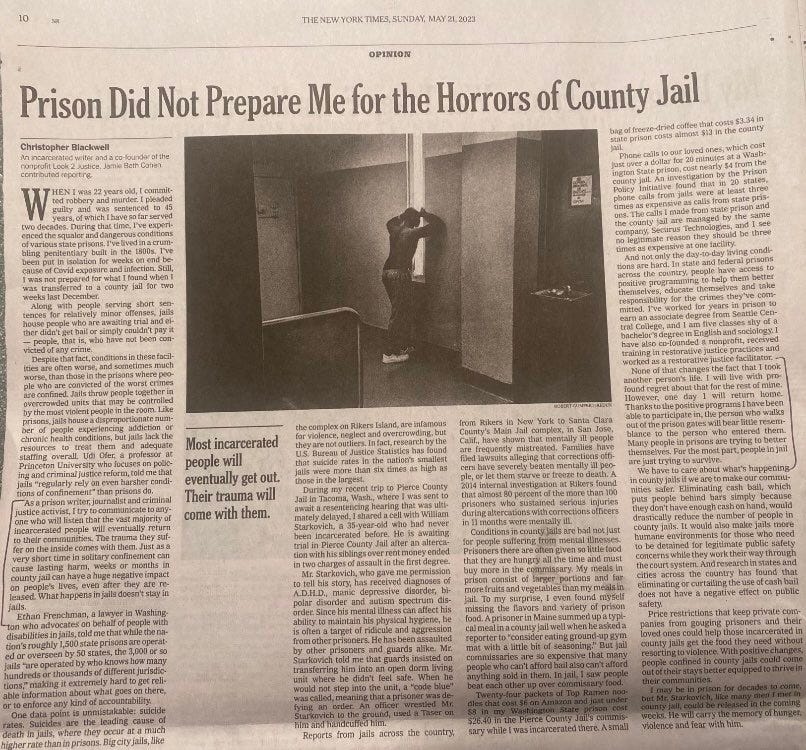We Hosted an Artist Power Convening
Plus 11 new projects, another story in the New York Times, and an extensive EA artist profile
New to Empowerment Avenue? You can learn more about our history, partnerships, and published work here. Subscribe to the newsletter here.
A year ago, Rahsaan and Christine began a proposal process to host an Artist Power Convening with support from Yerba Buena Center for the Arts in San Francisco, CA. When our peers selected us to lead a convening — with the goal to showcase and hear from incarcerated artists and share knowledge with like-minded individuals — we didn’t know when Rahsaan would be home. That made our May 20th convening all the more special. It was an incredible day sharing the early work of Visual Arts for Liberation, brainstorming collaborations, and most importantly directing work and opportunities to incarcerated artists. Many thanks to Tomieka Johnson, Chantell Jeannette, Corey Arthur, Dan Longan, O. Smith, Stan-Bey, Mark Cádiz aka Rev. M. Seishin and Lamavis Comundoiwilla for sharing your insight.
We are also excited to announce our outside support team is growing. Miye Sugino has an internship with us this summer and De’jon Joy is our new assistant director. We asked them to introduce themselves:
Hi everyone, I’m Miye. My background is in visual art and writing, which I’m also studying as a student at Yale. I’ve been primarily involved in EA through the visual arts track and am so excited to be part of this work!
Wassup, My name is De’jon. I am a community activist with a passion for building people power. Currently working as an Organizing Director and student at SF State. EA has welcomed me with open arms and I look forward to working with you all!
From left to right: Miye, Christine, Rahsaan, Emily, Su (the very first EA supporter!) and De’jon
Our Latest Work
Christopher Blackwell had two powerful pieces published this month. The first in The Appeal1 is about his firsthand experience with prison labor and how forcing incarcerated people "to submit to exploitation and abuse for the benefit of corporations does not help victims of crime or make society safer." The second was published in a Sunday edition of The New York Times. For the opinion section he wrote about how two decades in prison didn’t prepare him for the horrors of county jail. “I’ve spent the majority of my life incarcerated, but not even that prepared me for the horror & exploitation I saw on a recent trip to county jail,” he wrote on Twitter. This is Christopher’s second piece for the Times — what an accomplishment!
Chanell Burnette became a contributor to Marshall Project Life Inside2 this month. She writes about becoming a grandmother from prison and reflecting on her two sons, who were very young when she was incarcerated 18 years ago. “In that moment, I felt joy and a peace that was undefinable. It was like something had come over me — I just knew that my son’s life had been changed for the better, that this baby would be the blessing he needed to alter the course of his life,” she writes.
Jonathan Kirkpatrick produced more pieces for Filter3. He wrote about the lack of meds for stimulant use disorder: “The most harmful thing about meth is that it’s illegal. Some people struggle with problematic use and some people use while maintaining their day-to-day lives, but everyone is destabilized the moment law enforcement is involved.” And he also wrote about how harm reduction overlooks Hepatitis A and B: "Hepatitis A and B disproportionately impact people who inject drugs, people who’ve lost access to housing and people who do survival sex work. These are the same people disproportionately impacted by prison."
Right before his call from prison cut off, JShawn Guess remembers his mom saying, "Son, I need you..." He tried to call back but couldn't afford to put more phone credits on his account. Those were the last words he heard from his mom. Read JShawn’s heartbreaking recount of this final conversation in The Appeal.
As even more evidence of JShawn’s experience, EA writer Steve Brooks and EA volunteer Olivia Heffernan co-reported a piece for The Appeal about how even though calls are free, California prisoners still face communication obstacles. Months-long outages, equipment shortages, and unreliable service are some of the challenges that have plagued the new telecoms contract in California prisons.
Ryan Moser had a front page story for Metro Philadelphia4 this month. He explores how the 76ers’s potential $1.3 billion sports arena could impact a historic neighborhood—and how a practice facility already failed another community by not hiring local residents. He writes: “While the basketball players enjoy a state-of-the-art facility with massage tables, hot tubs, and professional chefs, their neighbors struggle with mental health issues, addiction, homelessness, and poverty.”
In the first story an EA writer has published for Slate5, Raymond Williams wrote a story on how COVID is treated like contraband. “Not a single prisoner was going to ask for help or alert the authorities to the illness. The coronavirus was on our minds. However, it wasn’t COVID-19 that we feared, but the response by prison authorities. For precisely this reason, we kept silent.”
From Antoine Davis for The Good Men Project6, "Rejecting Violence: A Necessary Response to Toxic Masculinity” is about how manhood is threatened when men don’t respond with violence in prison—but how support and choices can foster tenderness in society’s hardest places. “We were taught to be indifferent and calloused about the heartaches we experienced in life,” he writes. “So when those feelings arose, I began to see myself as inadequate and less of a man.”
Felix Sitthivong continues his twice-monthly column for International Examiner7. The latest one is a "mail call" answering the common question: What do you miss most about home? He’ll be doing this segment every few months where he’ll interview folks about life on the inside. “Please keep the questions coming!” he says.
You can find Kwaneta Harris’s work featured in the latest Muchacha Fanzine, a zine dedicated to incarcerated mothers and conversations around mass incarceration. If you buy a zine, 25% of all zine proceeds benefit Philadelphia Community Bail Fund’s "Black Mamas Bail Out Campaign”!
Last but not least, we are so thrilled to share the powerful collaborative project from Vera Institute and PEN America on the human toll of jails. It features work from EA founder Rahsaan Thomas and EA writer Ryan Moser. View the full project and read the stories here.
Inside/Outside Insights
For folks in Washington DC: This August, Christopher Blackwell is hosting an event with Busboys And Poets to uplift the work of the nonprofit he co-founded, Look2Justice. You'll need to RSVP to attend. And you can donate to his org here.
More of this, please! Huge congrats to EA artist Gary Harrell, who was extensively profiled by The Sacramento Bee about his life and his art. Empowerment Avenue began working with Gary while he was still inside San Quentin, and EA's Visual Arts for Liberation Director Christine Lashaw is quoted in the article. We’d love to see more artists and writers recognized for their work in mainstream outlets.
Be sure to catch Aaron Olson on the Subculture podcast with Chris Harper about Life in Prison. He gives Empowerment Avenue a shout out!
Want to connect with us more?
Follow us on Twitter and Instagram | Donate to our work here | Learn more on our website here | Build with us at empowermentave@gmail.com
The Appeal is a nonprofit news organization dedicated to exposing how the U.S. criminal legal system fails to keep people safe and perpetuates harm. They pay $1/word.
The Marshall Project’s Life Inside series publishes weekly first-person essays from people who live or work in the criminal justice system. Pieces are between 1,000 and 1,400 words, and the rate per story is $100.
Filter's mission is to advocate through journalism for rational and compassionate approaches to drug use, drug policy, and human rights. They typically pay $300 per essay.
Metro Philadelphia is a free daily newspaper in Philadelphia which began publishing 23 years ago.
Slate is an online magazine that covers current affairs, politics, and culture in the United States. They pay around $400 for online stories.
The Good Men Project is a website that examines what it means to be a good man in today's society.
International Examiner is the oldest and largest nonprofit, pan-Asian Pacific American publication in the Northwest. They pay $100 for an opinion piece.







